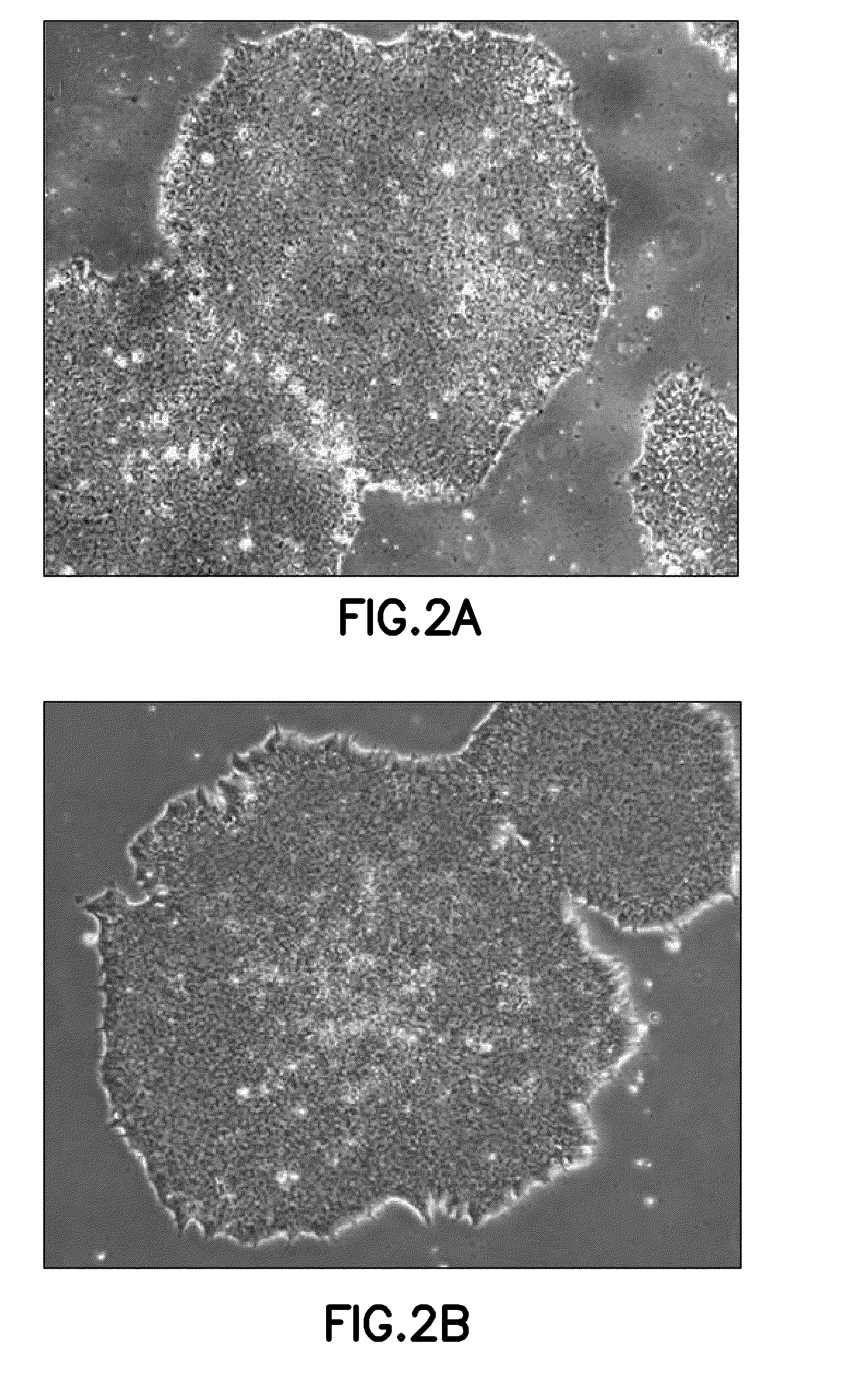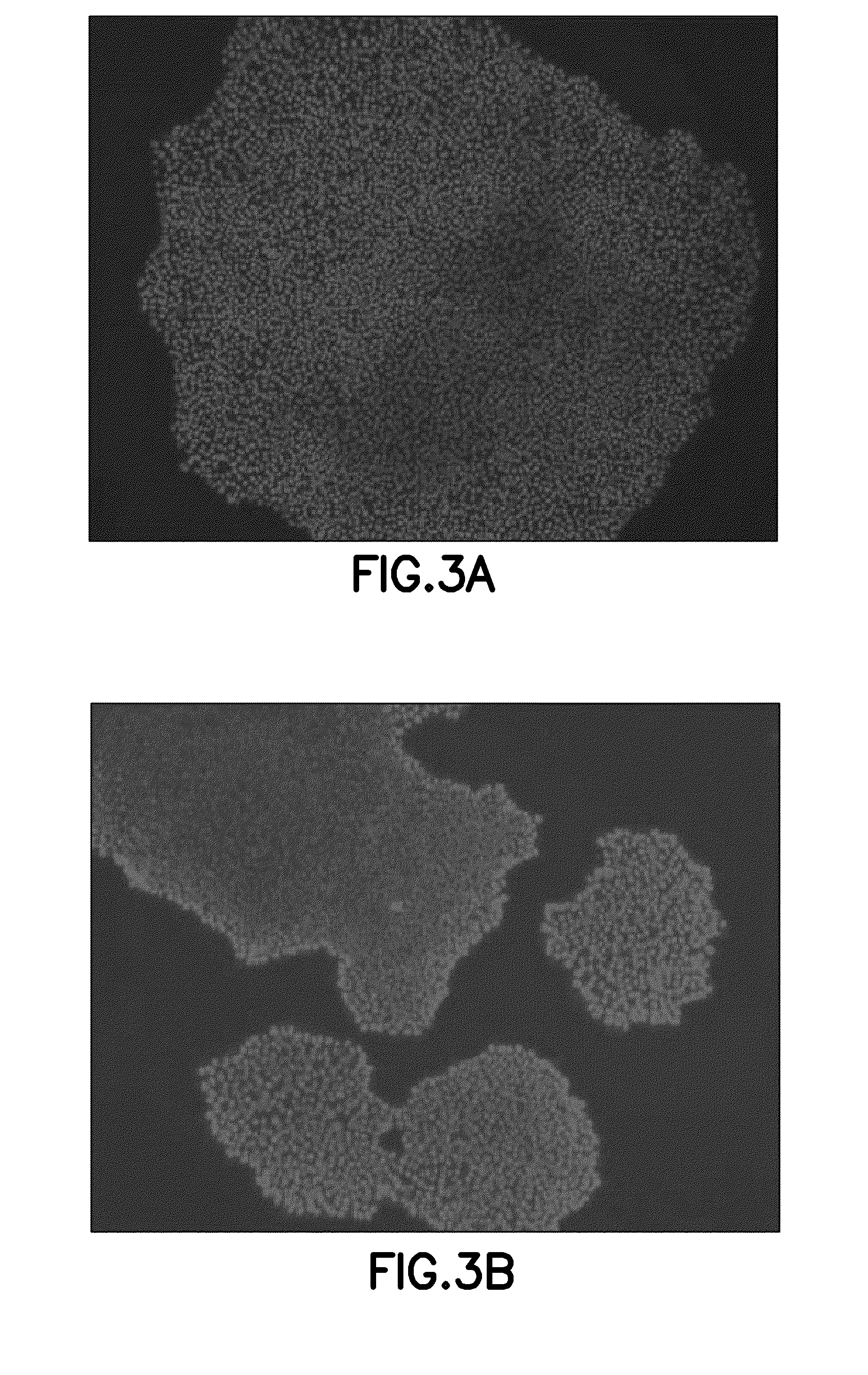Defined cell culturing surfaces and methods of use
a defined cell and surface technology, applied in the field of defined cell culturing surfaces, can solve the problems of high experimental variability and achieve the effect of favorable avoidance of stem cell differentiation and good stem cell attachment characteristics
- Summary
- Abstract
- Description
- Claims
- Application Information
AI Technical Summary
Benefits of technology
Problems solved by technology
Method used
Image
Examples
example 1
ECM Coating on Chemically Defined Plasma Polymerized Surfaces
[0062]Chemically defined plasma polymerized culture vessels (12 or 6 multiwell plate format) were coated with various extracellular matrix (ECM) proteins. Individual or combined ECM proteins, diluted in Dulbecco's phosphate buffered saline (DPBS) or DMEM / F12 media, were added (1 mL / well for 6 well plates and 0.5 mL / well for 12 or 24 well plates) and the plates were coated for 2 hours at room temperature or at 37° C. Coating solution was removed immediately prior to use for hES cell culture experiments. The following ECMs were used in the experiment: ECMs include but are not limited to human fibronectin, human laminin, human vitronectin, human collagen IV, BD Matrigel™ hESC-qualified Matrix, ProNectin® F Plus; a fibronectin-like engineered protein polymer from Sigma; Retronectin another recombinant fragment of human fibronectin from Takara Bio USA.
[0063]Plasma polymerized 6 well plates (BD Primex 1 (which includes amines an...
example 2
Culture of Human Embryonic Stem Cells on ECM Coated Plasma Polymerized Surfaces
hES Cell Culture on ECM-Coated Plasma Polymerized Surface
[0068]hES cells (H1, H9 or H14 lines from WiCell Institute) were initially plated onto plasma polymerized plates (with or without ECM coating) from positive control plates (i.e. hESC cells grown on 6 well TC plates coated with BD Matrigel™ hESC-qualified Matrix and grown in mTeSR™1 medium).
[0069]Cells on positive control plates were treated with dispase (2 mg / mL) for 5 minutes at 37° C., followed by four quick washes with DMEM / F12 medium and then mechanically dissected to small clumps in a small volume of mTeSR™1 medium using plastic pipettes or pipette tips. Clumps of hES cells resuspended in mTeSR™1 medium were seeded onto test surfaces at a 1:3 to 1:6 split ratio and cultured in an incubator at 5% CO2 in humidified air at 37° C. Culture medium was replaced daily and cells were typically dissociated every 4 to 6 days after initial plating.
hESC Dis...
example 3
Characterization of Undifferentiated hESCs
[0079]Morphological analysis (FIG. 2) reveals that hES cells maintained a predominantly undifferentiated state when cultured with mTeSR™1 on BD Primex 1 plates (Cat #359296) coated with BD human Fibronectin (FIG. 2B) and was comparable to those cultured on positive control substrate (TC plates coated with BD Matrigel™ hESC-qualified matrix, FIG. 2A).
[0080]Expression of the undifferentiated marker OCT-3 / 4 was comparable for cells cultured with mTeSR™1 on BD Primex 1 plates coated with BD human fibronectin (FIG. 3B) and on positive control substrate (TC plates coated with BD Matrigel™ hESC-qualified matrix, FIG. 3A).
[0081]Quantitative FACS analysis (protocol outlined below in Example 5) revealed that expression of undifferentiated hES cell-specific marker expression (OCT-3 / 4 and SSEA-4) for hES cells (H9 line) cultured on BD Primex 1 coated with BD human fibronectin for sixteen passages were comparable to positive control cells (cultured on TC...
PUM
| Property | Measurement | Unit |
|---|---|---|
| Fraction | aaaaa | aaaaa |
| Concentration | aaaaa | aaaaa |
| Concentration | aaaaa | aaaaa |
Abstract
Description
Claims
Application Information
 Login to View More
Login to View More - R&D
- Intellectual Property
- Life Sciences
- Materials
- Tech Scout
- Unparalleled Data Quality
- Higher Quality Content
- 60% Fewer Hallucinations
Browse by: Latest US Patents, China's latest patents, Technical Efficacy Thesaurus, Application Domain, Technology Topic, Popular Technical Reports.
© 2025 PatSnap. All rights reserved.Legal|Privacy policy|Modern Slavery Act Transparency Statement|Sitemap|About US| Contact US: help@patsnap.com



